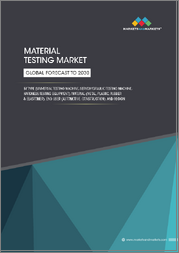
|
시장보고서
상품코드
1642492
재료 시험 시장 보고서 : 유형, 재료, 최종 이용 산업, 지역별(2025-2033년)Material Testing Market Report by Type, Material, End Use Industry, and Region 2025-2033 |
||||||
전 세계 재료 시험 시장 규모는 2024년 68억 달러에 달했습니다. IMARC Group은 향후 2033년까지 92억 달러에 이를 것으로 예상했으며, 2025년부터 2033년까지 3.33%의 성장률(CAGR)을 나타낼 것으로 예측했습니다. 이 시장은 시험 기기의 급속한 기술 발전, 건설 및 인프라 개발 프로젝트 증가, 최종 이용 산업의 광범위한 확대, 품질 보증과 규제 준수의 중시의 고조, 연구 개발(R&D)에 대한 투자 증가, 지속가능성과 환경에 대한 영향의 중시의 고조 등을 배경으로 역동적인 성장을 이루고 있습니다.
재료 시험은 다양한 재료의 물리적, 기계적, 화학적 특성을 평가하고 분석하는 체계적인 프로세스입니다. 재료의 품질, 내구성 및 성능에 대한 귀중한 통찰력을 제공하여 다양한 용도의 재료를 선택, 개발 및 개선하는 데 도움이 됩니다. 화학 조성, 내식성, 반응성 및 기타 화학적 특성을 조사했습니다. 신재료의 개발과 기존재료의 개량을 서포트하고, 산업계 전체의 기술발전으로 이어집니다. 임플란트, 보철물, 의료기기에 사용되는 재료의 생체 적합성과 내구성을 보장하는 데 사용됩니다.
세계의 다양한 산업의 확대가 재료 시험 기술에 대한 수요를 유발하고 있습니다. 게다가 전기차(EV)의 판매량 증가는 전도성, 열 관리, 경량 특성을 강화한 재료에 대한 요구를 촉진하고 있습니다. 재료 시험은 배터리 및 충전 인프라와 같은 EV 부품에 대한 재료의 적합성을 검증합니다. 이와는 별도로 산업의 디지털 변혁으로 디지털 트윈과 시뮬레이션 모델의 통합이 진행되고 있습니다. 재료 시험 데이터는 이러한 모델에 공급되어 가상 테스트와 분석을 가능하게 하고, 시장 출시까지의 시간을 단축하고, 전반적인 효율을 향상시킵니다. 또한, 태양전지판, 풍력 터빈, 에너지 저장 시스템을 위한 내구성이 높고 효율적인 재료에 대한 재생 가능 에너지 분야의 의존도가 증가함에 따라 시장 성장이 강화되고 있습니다.
재료 시험 시장 경향 및 촉진요인:
기술 발전과 혁신
기술의 급속한 발전은 시장 성장을 강화하는 중요한 요소 중 하나입니다. 인공지능, 머신러닝, 자동화와 같은 첨단 기술의 통합은 보다 효율적이고 정확한 테스트 프로세스를 제공합니다. 자동화된 테스트 장비는 광범위한 테스트를 높은 정밀도와 재현성으로 수행할 수 있으므로 인적 오류를 줄이고 결과의 신뢰성을 높이는 데 도움이 됩니다. 이와는 별도로 비파괴검사(NDT)법 등 고도의 시험기술의 개발로 재료분석의 능력도 확대하고 있습니다. 초음파, 엑스레이 투시, 열화상과 같은 NDT 기술은 손상 없이 재료의 종합적인 평가를 가능하게 합니다.
지속가능성과 환경문제
환경의 지속가능성에 대한 세계적인 우려 증가는 환경친화적이고 환경에 미치는 영향이 적은 재료를 개발하는 것을 산업계에 촉구하고 있습니다. 재료 시험은 재활용, 에너지 효율, 탄소 발자국 등의 요소를 평가하여 재료의 지속가능성을 평가하는 데 도움이 됩니다. 이와는 별도로, 환경 친화적이고 지속 가능한 관행을 따르는 제품에 대한 개인, 정부 및 조직의 선호도가 증가함에 따라 환경 프로파일을 개선한 재료에 대한 수요를 유발하고 있으며, 재료 시험은 이러한 기준을 충족하는 재료를 식별하는 데 도움이 됩니다. 재료시험은 포장재료의 재활용성과 건축재료의 에너지 효율을 평가함으로써 보다 친환경적이고 지속가능한 제품의 개발에 기여합니다.
다양한 용도로 사용자 정의
자동차 산업의 확대와 안전성 저하 없이 연비 향상을 위한 가볍고 내구성 있는 재료를 비롯한 개별화된 솔루션에 대한 수요 증가가 시장 성장을 뒷받침하고 있습니다. 재료 시험은 원하는 결과를 얻기 위해 필요한 최적의 조성과 특성을 확인하는 데 도움이 됩니다. 이 외에도 산업계는 신뢰성과 내구성을 높이기 위해 재료 성능을 최적화하는 데 주력하고 있습니다. 또한, 철저한 재료 시험을 실시함으로써, 제조업체는 상이한 배합 및 가공 방법이 커스터마이즈 및 성능에 어떤 영향을 미치는지를 평가할 수 있습니다. 이를 통해 사용자 정의 및 성능의 원하는 균형을 달성하기 위해 재료 조성 및 가공 기술에 대한 충분한 정보를 기반으로 선택이 가능합니다.
목차
제1장 서문
제2장 조사 범위와 조사 방법
- 조사의 목적
- 이해관계자
- 데이터 소스
- 1차 정보
- 2차 정보
- 시장 추정
- 상향식 접근
- 하향식 접근
- 조사 방법
제3장 주요 요약
제4장 소개
- 개요
- 주요 업계 동향
제5장 세계의 재료 시험 시장
- 시장 개요
- 시장 실적
- COVID-19의 영향
- 시장 예측
제6장 시장 분석 : 유형별
- 만능 시험기
- 시장 동향
- 시장 예측
- 서보 유압 시험기
- 시장 동향
- 시장 예측
- 경도 시험기
- 시장 동향
- 시장 예측
- 충격 시험기
- 시장 동향
- 시장 예측
- 비파괴 검사기
- 시장 동향
- 시장 예측
제7장 시장 분석 : 재료별
- 금속 및 합금
- 시장 동향
- 시장 예측
- 플라스틱
- 시장 동향
- 시장 예측
- 고무와 엘라스토머
- 시장 동향
- 시장 예측
- 세라믹 및 복합재료
- 시장 동향
- 시장 예측
- 기타
- 시장 동향
- 시장 예측
제8장 시장 내역: 최종 이용 산업별
- 자동차
- 시장 동향
- 시장 예측
- 건설
- 시장 동향
- 시장 예측
- 교육
- 시장 동향
- 시장 예측
- 항공우주 및 방어
- 시장 동향
- 시장 예측
- 석유 및 가스
- 시장 동향
- 시장 예측
- 에너지 및 전력
- 시장 동향
- 시장 예측
- 기타
- 시장 동향
- 시장 예측
제9장 시장 분석 : 지역별
- 북미
- 미국
- 캐나다
- 아시아태평양
- 중국
- 일본
- 인도
- 한국
- 호주
- 인도네시아
- 기타
- 유럽
- 독일
- 프랑스
- 영국
- 이탈리아
- 스페인
- 러시아
- 기타
- 라틴아메리카
- 브라질
- 멕시코
- 기타
- 중동 및 아프리카
- 시장 동향
- 시장 분석 : 국가별
- 시장 예측
제10장 SWOT 분석
- 개요
- 강점
- 약점
- 기회
- 위협
제11장 밸류체인 분석
제12장 Porter's Five Forces 분석
- 개요
- 구매자의 협상력
- 공급기업의 협상력
- 경쟁도
- 신규 진입업자의 위협
- 대체품의 위협
제13장 가격 분석
제14장 경쟁 구도
- 시장 구조
- 주요 기업
- 주요 기업 프로파일
- Admet Inc.
- Ametek Inc.
- Applied Test Systems LLC
- Illinois Tool Works Inc.
- Labquip
- Mistras Group Inc.
- Mitutoyo Corporation
- MTS Systems Corporation
- Shimadzu Corporation
- Tinius Olsen Ltd.
- Wirsam Scientific
- ZwickRoell AG
The global material testing market size reached USD 6.8 Billion in 2024. Looking forward, IMARC Group expects the market to reach USD 9.2 Billion by 2033, exhibiting a growth rate (CAGR) of 3.33% during 2025-2033. The market is experiencing robust growth, driven by the rapid technological advancements in testing equipment, growing construction and infrastructure development projects, widespread expansion of end-use industries, increasing emphasis on quality assurance and regulatory compliance, rising investment in research and development (R&D), and a heightened focus on sustainability and environmental impact.
Material testing is a systematic process that involves evaluating and analyzing the physical, mechanical, and chemical properties of various materials. It provides valuable insights into the quality, durability, and performance of materials, aiding in the selection, development, and improvement of materials for diverse applications. It examines chemical composition, corrosion resistance, reactivity, and other chemical attributes. It supports the development of new materials and the improvement of existing ones, which leads to technological advancements across industries. It is used to ensure the biocompatibility and durability of materials employed in implants, prosthetics, and medical instruments.
The expansion of various industries across the globe is catalyzing the demand for material testing techniques. Additionally, increasing sales of electric vehicles (EVs) are driving the need for materials with enhanced electrical conductivity, thermal management, and lightweight properties. Material testing verifies the suitability of materials for EV components, such as batteries and charging infrastructure. Apart from this, the digital transformation of industries is resulting in the integration of digital twins and simulation models. Material testing data feeds into these models, enabling virtual testing and analysis, reducing time-to-market, and enhancing overall efficiency. Furthermore, the rising reliance of the renewable energy sector on durable and efficient materials for solar panels, wind turbines, and energy storage systems is strengthening the growth of the market.
Material Testing Market Trends/Drivers:
Technological advancements and innovations
Rapid advancements in technology represent one of the key factors strengthening the growth of the market. The integration of cutting-edge technologies, such as artificial intelligence, machine learning, and automation, is resulting in more efficient and accurate testing processes. Automated testing equipment can perform a wide range of tests with high precision and repeatability, which aids in reducing human errors and enhancing the reliability of results. Apart from this, the development of advanced testing techniques, such as non-destructive testing (NDT) methods, has expanded the capabilities of material analysis. NDT techniques, including ultrasound, radiography, and thermal imaging, enable comprehensive evaluation of materials without causing damage.
Sustainability and environmental concerns
The growing global concerns about environmental sustainability are encouraging industries to develop materials that are eco-friendly and have a lower environmental impact. Material testing helps in evaluating the sustainability of materials by assessing factors, such as recyclability, energy efficiency, and carbon footprint. Apart from this, rising preferences of individuals, governments, and organizations for products that are eco-friendly and align with sustainable practices are catalyzing the demand for materials with improved environmental profiles, and material testing helps identify materials that meet these criteria. Material testing contributes to the development of greener and more sustainable products by assessing the recyclability of packaging materials or the energy efficiency of construction materials.
Customization for diverse applications
The expansion of the automotive industry and the escalating demand for personalized solutions like lightweight and durable materials to enhance fuel efficiency without compromising safety are favoring the market growth. Material testing aids in identifying the optimal composition and characteristics required to achieve the desired outcomes. Apart from this, industries are also focusing on optimizing the performance of materials to enhance reliability and durability. Furthermore, by conducting thorough material testing, manufacturers can assess how different formulations and processing methods impact customization and performance. This enables them to make informed choices about material compositions and processing techniques to achieve the desired balance between customization and performance.
Material Testing Market Segmentation:
Breakup by Type:
Universal Testing Machines
Servohydraulic Testing Machines
Hardness Testing Machines
Impact Testing Machines
Non-Destructive Testing Machines
Non-destructive testing machines dominate the market
Breakup by Material:
Metals and Alloys
Plastics
Rubber and Elastomers
Ceramics and Composites
Others
Metals and alloys account for the majority of the market share
Breakup by End Use Industry:
Automotive
Construction
Education
Aerospace and Defense
Oil and Gas
Energy and Power
Others
Construction dominates the market
Breakup by Region:
North America
United States
Canada
Asia Pacific
China
Japan
India
South Korea
Australia
Indonesia
Others
Europe
Germany
France
United Kingdom
Italy
Spain
Russia
Others
Latin America
Brazil
Mexico
Others
Middle East and Africa
Competitive Landscape:
Companies are actively engaged in numerous activities to provide comprehensive testing solutions, advance technology, and meet the diverse needs of industries. These activities encompass a range of services, innovations, and initiatives that contribute to the evolution of the material testing sector. Additionally, they are continuously developing innovative testing techniques that enhance accuracy, efficiency, and versatility. They are investing in research and development (R&D) activities to create advanced methods for evaluating materials, such as using artificial intelligence and machine learning to analyze testing data and predict material behavior. Apart from this, they are integrating automation and digitalization into their testing processes.
The report has provided a comprehensive analysis of the competitive landscape in the market. Detailed profiles of all major companies have also been provided. Some of the key players in the market include:
Admet Inc.
Ametek Inc.
Applied Test Systems LLC
llinois Tool Works Inc.
Labquip
Mistras Group Inc.
Mitutoyo Corporation
MTS Systems Corporation
Shimadzu Corporation
Tinius Olsen Ltd.
Wirsam Scientific
ZwickRoell AG
Key Questions Answered in This Report
- 1. What is the market size for the global material testing market?
- 2. What is the global material testing market growth?
- 3. What are the global material testing market drivers?
- 4. What are the key industry trends in the global material testing market?
- 5. What is the impact of COVID-19 on the global material testing market?
- 6. What is the global material testing market breakup by type?
- 7. What is the global material testing market breakup by material?
- 8. What is the global material testing market breakup by end use industry?
- 9. What are the major regions in the global material testing market?
- 10. Who are the key companies/players in the global material testing market?
Table of Contents
1 Preface
2 Scope and Methodology
- 2.1 Objectives of the Study
- 2.2 Stakeholders
- 2.3 Data Sources
- 2.3.1 Primary Sources
- 2.3.2 Secondary Sources
- 2.4 Market Estimation
- 2.4.1 Bottom-Up Approach
- 2.4.2 Top-Down Approach
- 2.5 Forecasting Methodology
3 Executive Summary
4 Introduction
- 4.1 Overview
- 4.2 Key Industry Trends
5 Global Material Testing Market
- 5.1 Market Overview
- 5.2 Market Performance
- 5.3 Impact of COVID-19
- 5.4 Market Forecast
6 Market Breakup by Type
- 6.1 Universal Testing Machines
- 6.1.1 Market Trends
- 6.1.2 Market Forecast
- 6.2 Servohydraulic Testing Machines
- 6.2.1 Market Trends
- 6.2.2 Market Forecast
- 6.3 Hardness Testing Machines
- 6.3.1 Market Trends
- 6.3.2 Market Forecast
- 6.4 Impact Testing Machines
- 6.4.1 Market Trends
- 6.4.2 Market Forecast
- 6.5 Non-Destructive Testing Machines
- 6.5.1 Market Trends
- 6.5.2 Market Forecast
7 Market Breakup by Material
- 7.1 Metals and Alloys
- 7.1.1 Market Trends
- 7.1.2 Market Forecast
- 7.2 Plastics
- 7.2.1 Market Trends
- 7.2.2 Market Forecast
- 7.3 Rubber and Elastomers
- 7.3.1 Market Trends
- 7.3.2 Market Forecast
- 7.4 Ceramics and Composites
- 7.4.1 Market Trends
- 7.4.2 Market Forecast
- 7.5 Others
- 7.5.1 Market Trends
- 7.5.2 Market Forecast
8 Market Breakup by End Use Industry
- 8.1 Automotive
- 8.1.1 Market Trends
- 8.1.2 Market Forecast
- 8.2 Construction
- 8.2.1 Market Trends
- 8.2.2 Market Forecast
- 8.3 Education
- 8.3.1 Market Trends
- 8.3.2 Market Forecast
- 8.4 Aerospace and Defense
- 8.4.1 Market Trends
- 8.4.2 Market Forecast
- 8.5 Oil and Gas
- 8.5.1 Market Trends
- 8.5.2 Market Forecast
- 8.6 Energy and Power
- 8.6.1 Market Trends
- 8.6.2 Market Forecast
- 8.7 Others
- 8.7.1 Market Trends
- 8.7.2 Market Forecast
9 Market Breakup by Region
- 9.1 North America
- 9.1.1 United States
- 9.1.1.1 Market Trends
- 9.1.1.2 Market Forecast
- 9.1.2 Canada
- 9.1.2.1 Market Trends
- 9.1.2.2 Market Forecast
- 9.1.1 United States
- 9.2 Asia Pacific
- 9.2.1 China
- 9.2.1.1 Market Trends
- 9.2.1.2 Market Forecast
- 9.2.2 Japan
- 9.2.2.1 Market Trends
- 9.2.2.2 Market Forecast
- 9.2.3 India
- 9.2.3.1 Market Trends
- 9.2.3.2 Market Forecast
- 9.2.4 South Korea
- 9.2.4.1 Market Trends
- 9.2.4.2 Market Forecast
- 9.2.5 Australia
- 9.2.5.1 Market Trends
- 9.2.5.2 Market Forecast
- 9.2.6 Indonesia
- 9.2.6.1 Market Trends
- 9.2.6.2 Market Forecast
- 9.2.7 Others
- 9.2.7.1 Market Trends
- 9.2.7.2 Market Forecast
- 9.2.1 China
- 9.3 Europe
- 9.3.1 Germany
- 9.3.1.1 Market Trends
- 9.3.1.2 Market Forecast
- 9.3.2 France
- 9.3.2.1 Market Trends
- 9.3.2.2 Market Forecast
- 9.3.3 United Kingdom
- 9.3.3.1 Market Trends
- 9.3.3.2 Market Forecast
- 9.3.4 Italy
- 9.3.4.1 Market Trends
- 9.3.4.2 Market Forecast
- 9.3.5 Spain
- 9.3.5.1 Market Trends
- 9.3.5.2 Market Forecast
- 9.3.6 Russia
- 9.3.6.1 Market Trends
- 9.3.6.2 Market Forecast
- 9.3.7 Others
- 9.3.7.1 Market Trends
- 9.3.7.2 Market Forecast
- 9.3.1 Germany
- 9.4 Latin America
- 9.4.1 Brazil
- 9.4.1.1 Market Trends
- 9.4.1.2 Market Forecast
- 9.4.2 Mexico
- 9.4.2.1 Market Trends
- 9.4.2.2 Market Forecast
- 9.4.3 Others
- 9.4.3.1 Market Trends
- 9.4.3.2 Market Forecast
- 9.4.1 Brazil
- 9.5 Middle East and Africa
- 9.5.1 Market Trends
- 9.5.2 Market Breakup by Country
- 9.5.3 Market Forecast
10 SWOT Analysis
- 10.1 Overview
- 10.2 Strengths
- 10.3 Weaknesses
- 10.4 Opportunities
- 10.5 Threats
11 Value Chain Analysis
12 Porters Five Forces Analysis
- 12.1 Overview
- 12.2 Bargaining Power of Buyers
- 12.3 Bargaining Power of Suppliers
- 12.4 Degree of Competition
- 12.5 Threat of New Entrants
- 12.6 Threat of Substitutes
13 Price Analysis
14 Competitive Landscape
- 14.1 Market Structure
- 14.2 Key Players
- 14.3 Profiles of Key Players
- 14.3.1 Admet Inc.
- 14.3.1.1 Company Overview
- 14.3.1.2 Product Portfolio
- 14.3.2 Ametek Inc.
- 14.3.2.1 Company Overview
- 14.3.2.2 Product Portfolio
- 14.3.2.3 Financials
- 14.3.3 Applied Test Systems LLC
- 14.3.3.1 Company Overview
- 14.3.3.2 Product Portfolio
- 14.3.4 Illinois Tool Works Inc.
- 14.3.4.1 Company Overview
- 14.3.4.2 Product Portfolio
- 14.3.4.3 Financials
- 14.3.4.4 SWOT Analysis
- 14.3.5 Labquip
- 14.3.5.1 Company Overview
- 14.3.5.2 Product Portfolio
- 14.3.6 Mistras Group Inc.
- 14.3.6.1 Company Overview
- 14.3.6.2 Product Portfolio
- 14.3.6.3 Financials
- 14.3.7 Mitutoyo Corporation
- 14.3.7.1 Company Overview
- 14.3.7.2 Product Portfolio
- 14.3.8 MTS Systems Corporation
- 14.3.8.1 Company Overview
- 14.3.8.2 Product Portfolio
- 14.3.8.3 Financials
- 14.3.9 Shimadzu Corporation
- 14.3.9.1 Company Overview
- 14.3.9.2 Product Portfolio
- 14.3.9.3 Financials
- 14.3.9.4 SWOT Analysis
- 14.3.10 Tinius Olsen Ltd.
- 14.3.10.1 Company Overview
- 14.3.10.2 Product Portfolio
- 14.3.10.3 Financials
- 14.3.11 Wirsam Scientific
- 14.3.11.1 Company Overview
- 14.3.11.2 Product Portfolio
- 14.3.12 ZwickRoell AG
- 14.3.12.1 Company Overview
- 14.3.12.2 Product Portfolio
- 14.3.12.3 Financials
- 14.3.1 Admet Inc.



















